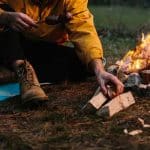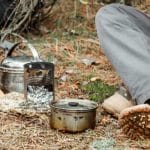The term “bushcraft” gets thrown around often, especially with the popularity of some TV shows involving survival or prepping themes. But bushcraft isn’t the same as survival mode out in the wilderness.
Bushcraft is the practice of depending on nature and its resources to make one’s way in the world. It’s about living off the land and in harmony with your natural surroundings.
Will bushcraft skills help in a survival situation? Yes, but survival connotes an emergency, and bushcraft isn’t necessarily about how to survive the apocalypse.
When I left the army after 20 years, I knew how to survive in harsh conditions, but what I learned and experienced wasn’t connected to self-sufficiency.
And it certainly wasn’t in touch with nature. As I began to understand and practice bushcraft skills, I became more acquainted with the two mindsets of bushcraft and survival.
- Bushcraft involves living off the land, off the grid, providing for yourself, and doing so for an extended period. That doesn’t mean you can’t practice bushcraft on a weekend camping trip, but it is more of a long-term skillset.
- Survival is just that: surviving, which implies “at all costs.” Survival mode doesn’t consider your effects on your environment but focuses on helping you survive until you can get to a safer, more stable space. It’s also a short-term-use skillset, as you don’t want to be in survival mode for weeks.
We’ll look at bushcraft skills, what makes them desirable to have, and some of the tools you need to practice these skills effectively.
What Are the Main Bushcraft Skills?
Shelter, water, and food — in that order— are what you need to survive, so the most basic bushcraft skills revolve around these. Again, you can apply these skills in a survival situation, but bushcraft is more of a lifestyle than an urgent situation.
Shelter
The first skill you’ll need to master revolves around constructing a shelter, and you have several options. Since bushcraft isn’t about camping, you’re not going to have a high-end, insulated tent where you can rest your head. Instead, you’ll build something, and you have a few options.
- A dugout shelter involves digging a trench, retaining the walls, then roofing the structure. It’s not a shelter for a flood-prone area, nor a spot near bodies of water. But sitting even a few inches below ground level can help keep you warm.
- Lean-to shelters may be the simplest to build. A lean-to can be as simple as leaning a panel against a tree. In weather that doesn’t involve freezing or gusting winds, it’s a good option, and it’s a quick build.
- An A-frame shelter is two lean-to shelters lashed together. This shelter provides better cover. With two walls, you can have some protection from wind and a better chance of staying somewhat dry in a rainstorm.
- A debris shelter — also known as a fallen-tree shelter — uses a fallen tree or something similar for a ridgepole. One end sits on the ground with the other on a stump or some other elevated surface. The walls are built from leaves and other debris (hence the name). It’s a modified A-frame that offers more protection.
To build these shelters, if you don’t have a paracord, you’ll need some type of rope, so take the time to learn about making cordage— rope you make from tree fibers. It can be handy and durable.
And if you’re working with rope, you need to know some basic knots to have lasting success with shelters. If you don’t know knots, start with these, all of which will serve you well.
- Square knot
- Bowline knot
- Clove hitch
- Figure eight
- Tautline hitch
Water
If you don’t have water, you’ll only last three days or so, no matter how great your shelter is. So once your shelter offers protection, it’s time to figure out the water situation. Bushcraft skills involve knowing how to find water and determine if it’s safe to drink and what to do to make it potable.
If you can’t see a lake or stream, pay attention to your surroundings (you should already be doing that, since bushcraft relies on being respectful of your environment and the other creatures that live in it).
Listen for the sounds of water, look for plants (cattails, for example) that only grow close to water, and pay attention to where the insects and animals gather. They need water, too, so if they’re drawn one way, they might be onto something.
If you can’t locate a water body, you’ll need to collect water, and you’ve got a few ways to do so.
Building a solar still sounds much more complicated than it is, and collecting rainwater can be as simple as sticking a bucket out in the rain.
Whatever method you choose, choose. You cannot survive without water, so don’t put it off.
The water you have may need filtering or sterilizing, or it may need both. Making a filter to remove debris can be as simple as pouring the water over some cloth — like a bandana or t-shirt — or you can build one using a bottle and varying sizes of rocks to catch debris, leaving just water.
If it’s cloudy or has observable algae, you may need to sterilize the water by boiling it, and for that, you’ll need a fire, which we’ll cover shortly.
Food
You’ve got some cover and water to drink, but in three weeks, you’ll be done if you haven’t come up with a food solution. Luckily, bushcraft skills mean you can use the forest as your grocery store.
Foraging, trapping, and hunting offer different prizes, but either or both can provide you with good food that doesn’t involve plastic trash or preservatives.
Foraging
Knowledge of your local geography is an invaluable tool for foraging. It’s an extreme example, but if you know that you’re in the desert, you can expect to find cacti there — a good source of food and water.
But also knowing what plants grow in your area can help you learn what plants are safe to eat and which mushrooms you absolutely must avoid.
Pretty much any forest will provide you with forageable foods.
- Berries
- Certain weeds
- Edible flowers
- Fruits
- Mushrooms
- Roots
- Seeds and nuts
- Tubers
Trapping and Hunting
Many people associate hunting with guns, camo, and deer stands, but there are other ways to provide for yourself in the bush. While it’s not technically hunting, trapping can put meat on your proverbial table. It’s also much less time- and labor-intensive than tracking your prey through the woods.
Different traps work for different critters, and here again, your knowledge of the area can help you know what animals you can expect to encounter. If you’re out in the desert, you shouldn’t expect to come upon any beavers, and knowing the perfect beaver trap will do little good out there.
Building traps for bushcraft usually involves materials you find in your surroundings, which means trees, branches, and other flora.
Your bushcraft life will be much easier if you make sure you have a bushcraft saw on hand. You don’t want to try sawing through branches with a knife, and you certainly shouldn’t rely on breaking them apart with your hands.
A woven fish trap is probably the most labor-intensive, but it can bring in a good yield if you’re by a stream or river. Deadfall traps are much easier, and spring snares bring effectiveness to the task.
No matter how good your traps are, if no animals find them, they’re useless. Before constructing or placing your traps, pay attention to the area, looking for signs that animals frequent the spot.
Tracks, scat, pawprints, and the remains of past meals are all good indicators that something trappable is active nearby.
As for actual hunting, you’ll need a good bushcraft knife when you corner your prey, and again when you clean and prepare it for cooking.
Your knife offers many more uses than those, though, so don’t skimp when choosing yours. A good bushcraft knife is invaluable. Whenever I get the question, “What is the most important bushcraft tool,” I tend to answer that it’s a reliable knife.
Making (and Maintaining) Fire
The above skills hold great importance— you have to eat, drink water, and have some shelter, but the importance of having access to fire can’t be overstated.
You’ll use it to cook the food you’ve trapped or hunted, keep warm in colder weather, and keep predators at bay. Bushcraft without fire is like AC/DC without a guitar player. It’s just not a good idea.
Bushcraft means you probably don’t have a lighter and accelerant with you, so you’ll need to know how to start a fire and keep it going.
Most of us understand the triangle of combustion, or the fire triangle (even if you’ve not heard those terms before): you need three things for fire, and those are fuel, heat, and oxygen.
Remember in Cast Away when Tom Hanks was trying to start a fire and failing over and over? The wood eventually breaks apart, and a little spark of fire springs to life for a bit.
He then realizes that there hadn’t been enough oxygen to let a fire take off until the wood broke and let some air in. He only had two legs of the triangle.
Fuel
You’ll gather wood and lay it up for your fire. Be sure you have varying sizes of wood, as you’re not going to have success setting one giant log on fire with a few sparks. Gather small branches for kindling, and once you get your fire started, add the small kindling pieces to help it grow.
The smallest stuff you’ll need is tinder: feathers, leaves, or wood shavings. These go at the friction point and will be the first things to ignite. They’ll burn for only a short time, so have your kindling ready.
Heat
The heat you’ll need can come from a variety of sources. Whichever you choose, practice that method before you head out into the woods.
You need to be able to start a fire reliably. Fire isn’t something that, out in the bush, you can just decide, “Well, I guess I don’t need a fire after all” if you’re having trouble getting one lit.
The methods of creating heat all rely on friction and, at their roots, are pretty similar. Everyone has heard the old trope about rubbing two sticks together, but that’s not really how it works.
A hand drill works by drilling a spindle against a fireboard, building up the heat until the tinder ignites.
A fireboard is just a flat piece of wood, and you can use bark or a branch. You’ll need to cut out a small depression in it, pile your tinder around that, then insert the spindle — a straight stick — in the depression.
Then roll the spindle between your hands, back and forth, until it produces enough heat to make embers in the tinder.
A bow drill works the same way, but instead of your hands, you wrap some string around the spindle and attach the ends to a curved or flexible branch or other stick.
Then you only have to move the stick back and forth to turn the spindle. You can turn the spindle faster with a bow drill, and it will be easier on your hands.
Another option is to create sparks with flint and steel, but this is another method that takes practice. Plus, it doesn’t rely on things you can easily find in the bush. But if you have it with you and know how to use it, the flint-and-steel method can be quick and effective.
Oxygen
Once the tinder turns to embers, get it to the kindling and blow on it (or fan it). Moving air over the embers provides more oxygen, and fire will erupt. Once the kindling catches, you can add your firewood. Don’t, however, just pile it on. If your firewood sits too close together, it may impede oxygen flow and choke out your fire.
If this happens, you’ll still have some coals for a bit, so you’ll have time to adjust the firewood, fan the coals, and reignite your fire.
Other Skills
When you’ve got all these skills down, you’ll want to continue your bushcraft education. I’ve mentioned knowing your area well for a few reasons, but there will be times you find yourself in an unfamiliar spot.
Learn how to navigate in the woods, getting your bearings from the sun and the stars, for example.
Also, the ability to make bushcraft tools can come in handy. You can make workable hammers, mallets, cutting tools, and even shovels out of rocks, cordage, branches, and antlers.
Your imagination is the limit, but you should work under the assumption that, eventually, your store-bought stuff will wear out. Knowing how to replace your tools by creating your own can be a real boon.
Heading Into the Bush
I hope I’ve made clear what bushcraft skills are and why they’re important. Remember that they’re different skills than those you’d use in survival mode, and they’re useful for camping, but bushcraft goes beyond a simple weekend camping trip.
The skills you need will help you survive, thrive, and enjoy your time in the bush.
- Know how to build a shelter.
- Be prepared to filter and sterilize water, and know how to find it since you literally can’t live without it.
- Learn to identify plants and other organic matter that are safe to forage for and consume.
- Develop your snare- and trap-building skills so you don’t have to live on nuts and berries exclusively.
Be safe, as always. These vital skills will help you do that, but they’ll also make your time in the bush better, more productive, and more fun. And for the skills listed here that you don’t have, you can learn much of what you need to know from this website.




